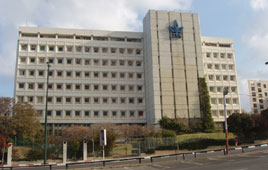(By the MFA)

Cancer researchers are constantly on the hunt for treatments that can selectively kill cancer cells, leaving healthy cells unharmed. They're now one step closer to that goal thanks to the work of Israeli scientists.
Prof. Eytan Ruppin of Tel Aviv University's Blavatnik School of Computer Science and Sackler Faculty of Medicine, along with Prof. Eyal Gottlieb of the Beatson Institute for Cancer Research in Glasgow, Scotland and Dr. Tomer Shlomi of the Technion Israel Institute of Technology have successfully created the first computerized genome-scale model of cancer cell metabolism.
As the researchers described recently in Nature, the model provides a platform from which to tailor targeted drugs that could shut down only malignant cells. "It's quite unique," says Ruppin. "Our team is the first to build a full-blown model of this in the computer, and the first to utilize the concept of selective therapy in cancer cell metabolism."
Three bioinformatics specialists in his lab at TAU worked on the model for nearly two years, painstakingly reconstructing the thousands of genes, reactions and metabolic processes in a kidney cancer cell. The model is generic, so it can also be used to find drugs for other kinds of cancer.
"There is a lot of work that needs to be done," says Ruppin, who earned his MD (1987) and PhD in computer science (1993) from TAU, where he is currently a professor of medicine and computer science. "We have identified drug candidates, not drugs. It takes years, and a lot of money, to go from the basic science stage where we are to developing a drug that actually works. We will be taking current targets for kidney cancer and moving them closer to being a real clinical drug." They'll also be investigating possibilities for other cancers.
Several major pharmaceutical companies are in talks with the university's technology transfer company, which is seeking investment support for the project.
Reviving old knowledge
Targeting the metabolism of the cancer cell may well hold the key to killing these cells efficiently. Cancer cells metabolize nutrients for growth and energy differently than normal cells do. That much has been known in the scientific world since the 1920s, says Ruppin. "There were initial attempts to work with this approach, and then it was abandoned for some reason. In the last five years, it has become very ‘hot' again in the research world."
Of course, back in the 1920s scientists didn't have the training or equipment available today. Ruppin's staff has the advantage of multidisciplinary training in computer science, to develop the algorithms to write the software, and in biology. Leading universities in Israel offer undergraduate and graduate joint programs in life sciences and computer science. "At TAU, this program is one of the flagships of the university. We have a center of excellence in bioinformatics supported by the Safra Foundation," says Ruppin.
The researchers identified likely drug targets by comparing their computer model to a pre-existing model of a normal human cell's metabolism. Their hypothesis regarding a drug to target the kidney cancer cell was then tested in a study led by Gottlieb's lab staff. They were able to verify the prediction in both mouse and human cell models, and to study these metabolic alterations in depth.
Existing chemotherapy drugs attack all proliferating cells in the body indiscriminately - not just malignant cells but also healthy hair and stomach-lining cells. This is why many cancer treatments cause nausea and hair loss. "We are going to continue to build models for other types of cancer, and seek selective drug therapies to defeat them," says Ruppin.








